Classtie
On this page, you find all documents, package deals, and flashcards offered by seller Classtie.
- 872
- 0
- 24
Community
- Followers
- Following
896 items
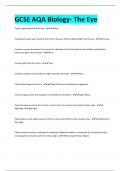
GCSE AQA Biology- The Eye
Tough supporting wall of the eye - Sclera Transparent outer layer found at the front of the eye. Refracts (bends) light into the eye - Cornea Contains muscles that allow it to control the diameter of the Pupil (hole in the middle) and therefore how much light enters the eye - Iris Focuses light onto the retina - Lens Contains receptor cells sensitive to light intensity and colour - Retina Controls the shape of the lens - Ciliary Muscles and Suspensory Ligaments Carries impulses from the r...
- Exam (elaborations)
- • 2 pages •
Tough supporting wall of the eye - Sclera Transparent outer layer found at the front of the eye. Refracts (bends) light into the eye - Cornea Contains muscles that allow it to control the diameter of the Pupil (hole in the middle) and therefore how much light enters the eye - Iris Focuses light onto the retina - Lens Contains receptor cells sensitive to light intensity and colour - Retina Controls the shape of the lens - Ciliary Muscles and Suspensory Ligaments Carries impulses from the r...
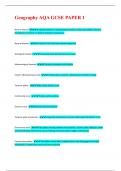
Geography AQA GCSE PAPER 1
Natural Hazard - A natural hazard is a natural process which could cause death, injury or disruption to humans, or destroy proprty or posesions. Natural disaster - A natural hzard that has actualy happened Geological hazards - Caused by kand and tectonic processes Meteorological hazards - Caused by weather and climate Factors affecting hazard risk - Urbanisation, poverty, development, climate change Tectonic plates - Slabs of the Earth's crust Continental crust - thicker and less dense ...
- Exam (elaborations)
- • 14 pages •
Natural Hazard - A natural hazard is a natural process which could cause death, injury or disruption to humans, or destroy proprty or posesions. Natural disaster - A natural hzard that has actualy happened Geological hazards - Caused by kand and tectonic processes Meteorological hazards - Caused by weather and climate Factors affecting hazard risk - Urbanisation, poverty, development, climate change Tectonic plates - Slabs of the Earth's crust Continental crust - thicker and less dense ...

Group 7: Atomic structure and the periodic table: Chemistry: GCSE (9:1)
Name of Group 7 elements The halogens Group 7 elements have similar chemical properties because they all have 7 outer shell electrons Diatomic molecule A molecule consisting of two atoms Chemical structure of group 7 diatomic molecules Pattern in melting points and boiling points down group 7 melting and boiling points decrease Pattern of reactivity down the halogens they get less reactive Reason for patterns in reactivity larger atomic radius, more shielding, less nuclear attractio...
- Exam (elaborations)
- • 4 pages •
Name of Group 7 elements The halogens Group 7 elements have similar chemical properties because they all have 7 outer shell electrons Diatomic molecule A molecule consisting of two atoms Chemical structure of group 7 diatomic molecules Pattern in melting points and boiling points down group 7 melting and boiling points decrease Pattern of reactivity down the halogens they get less reactive Reason for patterns in reactivity larger atomic radius, more shielding, less nuclear attractio...
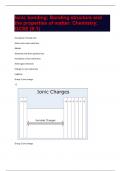
Ionic bonding: Bonding structure and the properties of matter: Chemistry: GCSE (9:1)
Formation of metal ions Atoms lose outer electrons Metals Elements that form positive ions Formation of non-metal ions Atoms gain electrons Charge on non-metal ions negative Group 1 ions charge +1 Group 2 ions charge +2 Group 6 ions charge -2 Group 7 ions charge
- Exam (elaborations)
- • 7 pages •
Formation of metal ions Atoms lose outer electrons Metals Elements that form positive ions Formation of non-metal ions Atoms gain electrons Charge on non-metal ions negative Group 1 ions charge +1 Group 2 ions charge +2 Group 6 ions charge -2 Group 7 ions charge
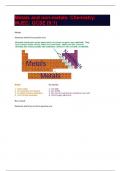
Metals and non-metals: Chemistry: WJEC: GCSE (9:1)
Metals Elements which form positive ions Non-metals Elements which do not form positive ions Metals position on periodic table on the left hand side Non-metals position on periodic table
- Exam (elaborations)
- • 8 pages •
Metals Elements which form positive ions Non-metals Elements which do not form positive ions Metals position on periodic table on the left hand side Non-metals position on periodic table
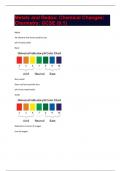
Metals and Redox: Chemical Changes: Chemistry: GCSE (9:1)
Metal An element that forms positive ions pH of metal oxide Basic Non-metal Does not form positive ions pH of non-metal oxide Acidic Reduction in terms of oxygen Loss of oxygen Oxidation in terms of oxygen Gain of oxygen Oxidation in terms of electrons Loss of electrons
- Exam (elaborations)
- • 8 pages •
Metal An element that forms positive ions pH of metal oxide Basic Non-metal Does not form positive ions pH of non-metal oxide Acidic Reduction in terms of oxygen Loss of oxygen Oxidation in terms of oxygen Gain of oxygen Oxidation in terms of electrons Loss of electrons

Naming Chemicals: Atomic structure and the periodic table: Chemstry: GCSE (9:1)
H - Hydrogen He - Helium Fe - Iron N - Nitrogen Na - Sodium F - Fluorine Li - Lithium C - Carbon CO2 - carbon dioxide O - Oxygen Mg - Magnesium
- Exam (elaborations)
- • 2 pages •
H - Hydrogen He - Helium Fe - Iron N - Nitrogen Na - Sodium F - Fluorine Li - Lithium C - Carbon CO2 - carbon dioxide O - Oxygen Mg - Magnesium
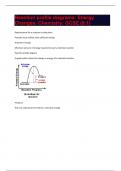
Reaction profile diagrams: Energy Changes: Chemistry: GCSE (9:1
Requirements for a reaction to take place Particles must collide, with sufficient energy Activation energy Minimum amount of energy required to start a chemical reaction Reaction profile diagram A graph which shows the change in energy of a chemical reaction Products The new substances formed by a chemical change
- Exam (elaborations)
- • 5 pages •
Requirements for a reaction to take place Particles must collide, with sufficient energy Activation energy Minimum amount of energy required to start a chemical reaction Reaction profile diagram A graph which shows the change in energy of a chemical reaction Products The new substances formed by a chemical change
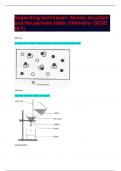
Separating techniques: Atomic structure and the periodic table: Chemstry: GCSE (9:1)
Mixture A combination of two or more substances that are not chemically joined. Filtration Separates insoluble solids from liquids. Crystallisation
- Exam (elaborations)
- • 10 pages •
Mixture A combination of two or more substances that are not chemically joined. Filtration Separates insoluble solids from liquids. Crystallisation
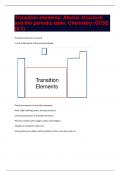
Transition elements: Atomic structure and the periodic table: Chemistry: GCSE (9:1)
Transition elements are found In the middle block of the periodic tableRe Physical properties of transition elements Hard, high melthing points, strong and dense. Chemical properties of transition elements Slow/no reaction with oxygen, water and halogens Charges on transition metal ions Form positive ions often with the ability to form more than one ion
- Exam (elaborations)
- • 3 pages •
Transition elements are found In the middle block of the periodic tableRe Physical properties of transition elements Hard, high melthing points, strong and dense. Chemical properties of transition elements Slow/no reaction with oxygen, water and halogens Charges on transition metal ions Form positive ions often with the ability to form more than one ion
